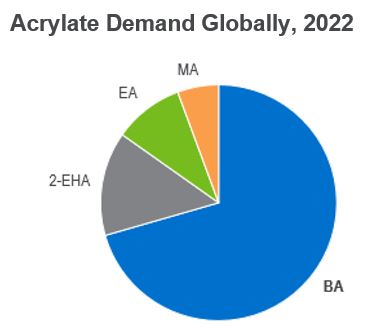Global Acrylate Esters Market Snapshot

Acrylate esters impart many desirable qualities to polymeric materials, such as colour stability and clarity, heat and aging resistance, enhanced weatherability, low temperature flexibility, as well as acid and base resistance. The esters impart characteristics of hardness, durability, tackiness and temperature resistance to varying degrees. Altering the selection and proportions of the esters permits tuning product properties over a wide range.
In addition to commodity esters, smaller quantities of other alkyl acrylates are produced from crude acrylic acid for specialty chemical applications. Functional acrylate oligomers and multifunctional acrylate esters are consumed as raw materials in radiation curable coatings, inks, electronics manufacturing processes, and adhesives. Small volume acrylates such as hydroxyalkyl esters and dialkylaminoethyl esters provide sites for initial or secondary cross-linking of polymers that are often necessary for hard, cured surfaces.
Acrylate esters are among the most versatile monomers for providing performance properties to a wide variety of polymers. In 2022 acrylate esters accounted for 44 percent of acrylic acid demand.
The key commodity acrylate esters include:
Butyl acrylate (BA)
Methyl acrylate (MA)
Ethyl acrylate (EA)
2-Ethylhexyl acrylate (2-EHA)
Acrylate Demand Globally 2022 - NexantECA
Butyl acrylate is the largest of the acrylates and is used in the production of acrylic, vinyl acrylic, and styrene acrylic copolymers. BA is also utilized as a raw material for creating acrylic fiber, adhesives, coatings, plastics, acrylic rubber, and emulsions.
Coating and paint production is one of the major uses of BA. It is commonly used as it contributes to the formulation of the coatings by enhancing adhesion, durability and weather resistance. Hence, BA finds it use in industrial paints and coatings that require high durability and adhesion.
In recent years, government push for a greener construction industry has supported demand growth of BA as it is used as one of the main component for low VOC paints; by using BA, paint producers achieve high gloss and better colour retention for paints.
BA is also consumed in the paper and packaging industry where it is used as a binder or coating component, providing improved strength and water resistance. A further key use is in the production of adhesives as it provides strong adhesion properties, allowing secure bonding of different packaging materials such as paper, cardboard and films.
Butyl acrylate capacity is concentrated in Asia Pacific with 74 percent of the total global supply. The leading, top five, producers of butyl acrylate all have production in Asia Pacific due to the region’s competitiveness. BASF remains as the leading global producer. Asia Pacific will continue to dominate supply of the market, with global BA demand expected to growth with a CAGR of 3.5 percent from 2025 to 2035.
Find out more…
The reports provide analysis and forecast to 2045 of supply and demand of the global markets, including a detailed demand, supply and net trade analysis for 40 countries with forecasts to 2045. Key demand trends, capacity announcements and trade trends are discussed.
